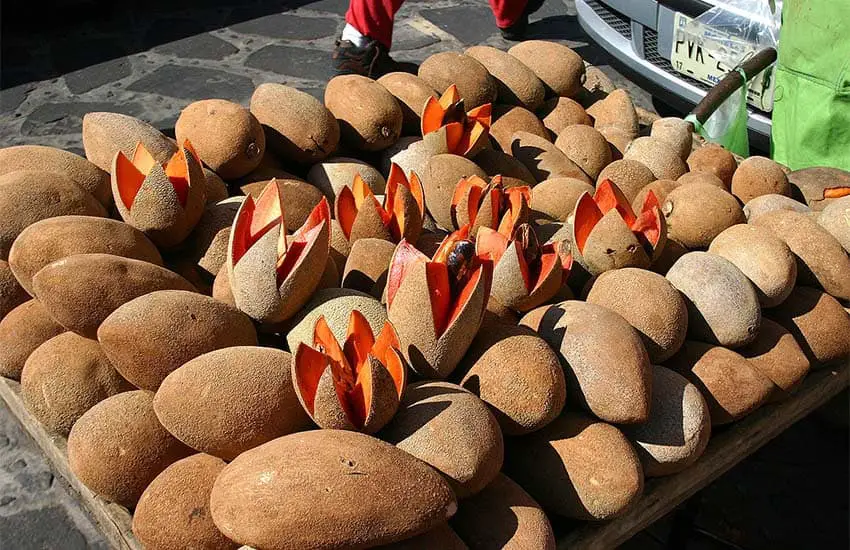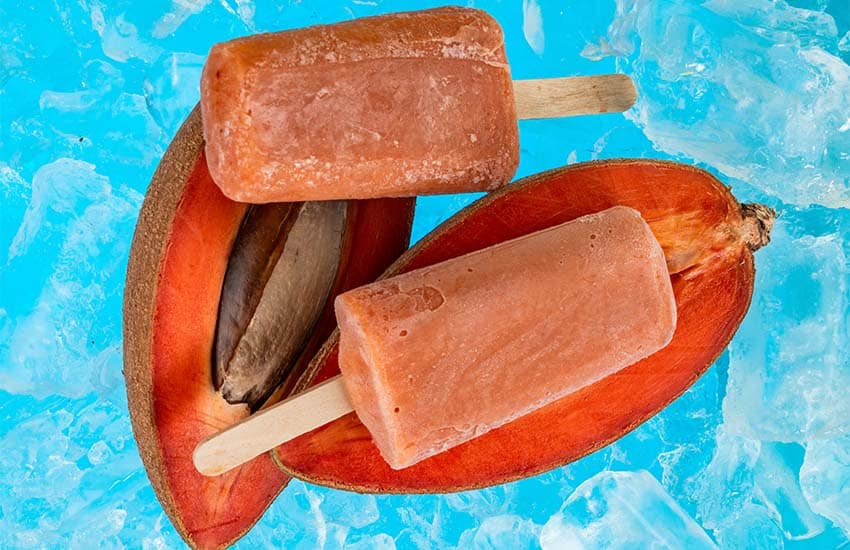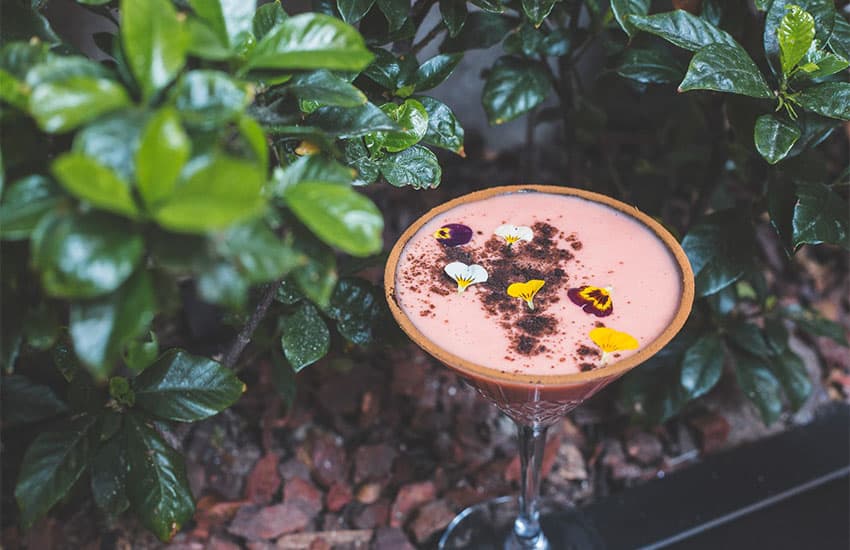Don’t judge a mamey by its cover: luscious fruit lies within

With its rough, brown skin and odd, elongated football-like shape, the mamey’s external appearance belies the luscious fruit within.
The sweet flesh inside is a brilliant deep coral-orange, with a taste that some describe as somewhere in the middle of a cantaloupe, an apricot and a papaya, while others compare it to a baked sweet potato or pumpkin pie. Mamey’s texture is smooth and creamy, like a ripe avocado, and despite its large size and the shiny black pit in the middle, it is classified as a berry.
When in season, you’ll find mamey (pronounced mah-MAY) not only in supermarkets but also in vendor markets and, in some areas, sold by the roadside. Just like mangoes, the trees grow big and live a long time, producing an abundance of fruit for more than 20 years. A mature tree can yield up to a half ton of fruit over a long growing season that lasts from January to July.
Formally called Mamey sapote or simply zapote in some parts of Mexico, this exotic fruit is widely grown for consumption at home as well as for export. Southern states like Veracruz, Chiapas, Oaxaca and Tabasco, as well as Yucatán, Quintana Roo and Guerrero, produce many varieties of sapotes (from the Nahuatl tzapotl), all with different colors and distinct flavors.
Traditional recipes and folk remedies abound: mamey is known for its antiparasitic and antibacterial qualities, as well as for having high levels of iron, fiber, antioxidants and beta-carotene, which contribute to healthy skin and digestion and improved blood circulation. And since mamey is about 80% water, it’s also low in calories.
The simplest way to eat mamey, of course, is just cut up. Its bright-orange color adds pizzazz to everything, whether in a fruit salad, blended into a smoothie or agua fresca or made into ice cream, flan or pudding. Ostensibly, mamey can be cut up and cooked like French fries, but I can’t vouch for that idea.
In some states, the mamey sapote seed, or pixtle, is used in traditional recipes, including the Oaxacan drink tejate and Tabasco’s sour atole. In Oaxaca, after the seeds are toasted and ground, the powder is added to hot chocolate to make it froth more.
A word of caution: Raw mamey sapote seeds contain cyanide, which is poisonous. Before using them in recipes, they need to be cooked and treated. Do not attempt this on your own!
When selecting mamey, look for unblemished fruit that gives gently when squeezed lightly, like a ripe peach or avocado. If they need to ripen, wrap the fruit in brown paper and leave out on your kitchen counter until it’s tender to the touch.
To prepare, slice the skin from top to bottom in four places and peel off. Slice the fruit away from the pit inside. Discard the pits and any white membrane under the skin, then slice the fruit as desired. Once you get the hang of it, you’ll be able to cut mamey in half, discard the pit and scoop out the bright orange flesh with a spoon.
Mamey Frozen Mousse
- 3 cups of mamey pulp
- ¼ cup evaporated milk
- 1 cup sweetened condensed milk
- 1 tablespoon vanilla
- 1 cup heavy whipping cream
In a blender or stand mixer, process mamey with the evaporated milk, condensed milk and vanilla; set aside. Whip the cream until doubled in volume. Gently fold the mamey mixture into whipped cream until incorporated. Transfer to a bowl and freeze for 8 hours, stirring from time to time to distribute the frozen parts. When firm and frozen, serve in bowls or cones.

Agua de Mamey
This can also be used to make bolis or popsicles.
- 1 cup of cubed mamey
- 2 Tbsp. honey/agave syrup
- Juice of 4 small limones or to taste
- 6 cups water
- Ice
Blend the fruit with a little of the water, lime juice and honey/agave syrup. Return to the pitcher with the rest of the water; mix well. Serve in glasses with ice.
Bolis de Mamey
- 1½ cups mamey pulp
- 1 liter regular milk
- 1 ½ cans sweetened condensed milk
- 1 ½ cups media crema
- 1 Tbsp. vanilla
Process mamey pulp in a blender until pureed. In a large bowl, whisk both milks, media crema, vanilla and mamey pulp until well incorporated. Pour into small plastic bags (or popsicle molds); twist and tie the bag at the top to close. Freeze at least eight hours or overnight.

Mamey Horchata
- 2 cups washed white rice
- 4 cups water
- 1 can sweetened condensed milk
- 3 cans evaporated milk
- 1 cinnamon stick
- 2 cups mamey pulp
- 1 Tbsp. vanilla
Bring water to a boil. Add cinnamon stick, vanilla and rice; turn heat to low, cover tightly and cook until the rice is done, about 20–25 minutes. (There will still be water in the pan but the rice will be tender.) Stir and let cool for 15 minutes. Discard cinnamon stick.
In a blender or food processor, pour rice and cooking water. Blend on high until smooth, working in batches if necessary. Strain into a large pitcher and add the condensed milk, evaporated milk and one more cup of room-temperature water.
In a blender, process the mamey and then strain through a wire-mesh strainer. Discard solids. Add mamey juice to the rice water mixture and stir well. Serve chilled over ice.
Flan de Mamey
- ½ cup sugar
- ½ cup water
- 4 cups mamey pulp
- 1 can sweetened condensed milk
- 2 whole eggs
- 2 egg yolks
Heat the sugar with the water in a saucepan over medium heat until sugar melts, turns golden brown and caramelizes a little. Pour this caramel into a mold or individual glass flan cups.

Blend the mamey with the condensed milk, eggs and egg yolks until thoroughly combined. Pour into mold or cups and cover with aluminum foil.
Fill a lasagna-size pan with boiling water to about an inch from the top; place cups or mold into pan. Cook at 350F (180C) for 40 minutes or until a toothpick inserted in the center comes out clean. Carefully remove from pan, chill at least three hours, unmold and serve.
Janet Blaser is the author of the best-selling book, Why We Left: An Anthology of American Women Expats, featured on CNBC and MarketWatch. She has lived in Mexico since 2006. You can find her on Facebook.
Source: Mexico News Daily

